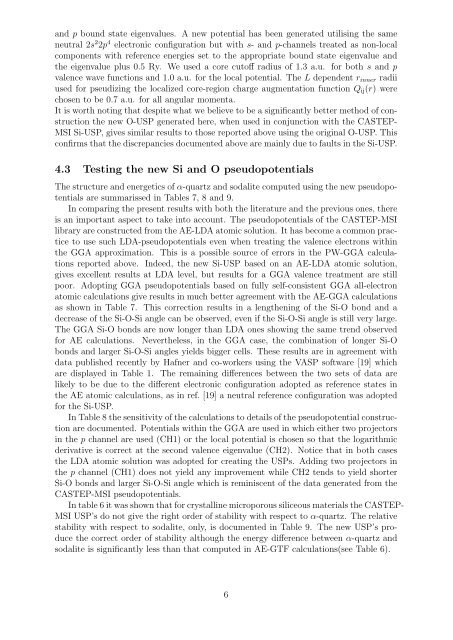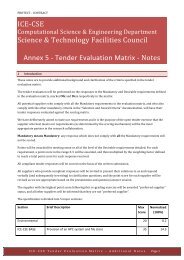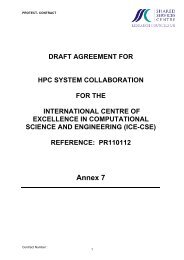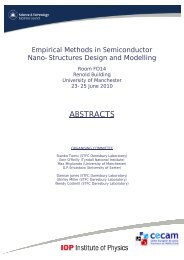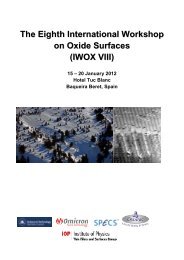New ultrasoft pseudopotentials for the study of silicates. - STFC's ...
New ultrasoft pseudopotentials for the study of silicates. - STFC's ...
New ultrasoft pseudopotentials for the study of silicates. - STFC's ...
Create successful ePaper yourself
Turn your PDF publications into a flip-book with our unique Google optimized e-Paper software.
and p bound state eigenvalues. A new potential has been generated utilising <strong>the</strong> sameneutral 2s 2 2p 4 electronic configuration but with s- and p-channels treated as non-localcomponents with reference energies set to <strong>the</strong> appropriate bound state eigenvalue and<strong>the</strong> eigenvalue plus 0.5 Ry. We used a core cut<strong>of</strong>f radius <strong>of</strong> 1.3 a.u. <strong>for</strong> both s and pvalence wave functions and 1.0 a.u. <strong>for</strong> <strong>the</strong> local potential. The L dependent r inner radiiused <strong>for</strong> pseudizing <strong>the</strong> localized core-region charge augmentation function Q ij (r) werechosen to be 0.7 a.u. <strong>for</strong> all angular momenta.It is worth noting that despite what we believe to be a significantly better method <strong>of</strong> construction<strong>the</strong> new O-USP generated here, when used in conjunction with <strong>the</strong> CASTEP-MSI Si-USP, gives similar results to those reported above using <strong>the</strong> original O-USP. Thisconfirms that <strong>the</strong> discrepancies documented above are mainly due to faults in <strong>the</strong> Si-USP.4.3 Testing <strong>the</strong> new Si and O <strong>pseudopotentials</strong>The structure and energetics <strong>of</strong> α-quartz and sodalite computed using <strong>the</strong> new <strong>pseudopotentials</strong>are summarissed in Tables 7, 8 and 9.In comparing <strong>the</strong> present results with both <strong>the</strong> literature and <strong>the</strong> previous ones, <strong>the</strong>reis an important aspect to take into account. The <strong>pseudopotentials</strong> <strong>of</strong> <strong>the</strong> CASTEP-MSIlibrary are constructed from <strong>the</strong> AE-LDA atomic solution. It has become a common practiceto use such LDA-<strong>pseudopotentials</strong> even when treating <strong>the</strong> valence electrons within<strong>the</strong> GGA approximation. This is a possible source <strong>of</strong> errors in <strong>the</strong> PW-GGA calculationsreported above. Indeed, <strong>the</strong> new Si-USP based on an AE-LDA atomic solution,gives excellent results at LDA level, but results <strong>for</strong> a GGA valence treatment are stillpoor. Adopting GGA <strong>pseudopotentials</strong> based on fully self-consistent GGA all-electronatomic calculations give results in much better agreement with <strong>the</strong> AE-GGA calculationsas shown in Table 7. This correction results in a leng<strong>the</strong>ning <strong>of</strong> <strong>the</strong> Si-O bond and adecrease <strong>of</strong> <strong>the</strong> Si-O-Si angle can be observed, even if <strong>the</strong> Si-O-Si angle is still very large.The GGA Si-O bonds are now longer than LDA ones showing <strong>the</strong> same trend observed<strong>for</strong> AE calculations. Never<strong>the</strong>less, in <strong>the</strong> GGA case, <strong>the</strong> combination <strong>of</strong> longer Si-Obonds and larger Si-O-Si angles yields bigger cells. These results are in agreement withdata published recently by Hafner and co-workers using <strong>the</strong> VASP s<strong>of</strong>tware [19] whichare displayed in Table 1. The remaining differences between <strong>the</strong> two sets <strong>of</strong> data arelikely to be due to <strong>the</strong> different electronic configuration adopted as reference states in<strong>the</strong> AE atomic calculations, as in ref. [19] a neutral reference configuration was adopted<strong>for</strong> <strong>the</strong> Si-USP.In Table 8 <strong>the</strong> sensitivity <strong>of</strong> <strong>the</strong> calculations to details <strong>of</strong> <strong>the</strong> pseudopotential constructionare documented. Potentials within <strong>the</strong> GGA are used in which ei<strong>the</strong>r two projectorsin <strong>the</strong> p channel are used (CH1) or <strong>the</strong> local potential is chosen so that <strong>the</strong> logarithmicderivative is correct at <strong>the</strong> second valence eigenvalue (CH2). Notice that in both cases<strong>the</strong> LDA atomic solution was adopted <strong>for</strong> creating <strong>the</strong> USPs. Adding two projectors in<strong>the</strong> p channel (CH1) does not yield any improvement while CH2 tends to yield shorterSi-O bonds and larger Si-O-Si angle which is reminiscent <strong>of</strong> <strong>the</strong> data generated from <strong>the</strong>CASTEP-MSI <strong>pseudopotentials</strong>.In table 6 it was shown that <strong>for</strong> crystalline microporous siliceous materials <strong>the</strong> CASTEP-MSI USP’s do not give <strong>the</strong> right order <strong>of</strong> stability with respect to α-quartz. The relativestability with respect to sodalite, only, is documented in Table 9. The new USP’s produce<strong>the</strong> correct order <strong>of</strong> stability although <strong>the</strong> energy difference between α-quartz andsodalite is significantly less than that computed in AE-GTF calculations(see Table 6).6


